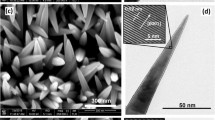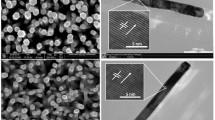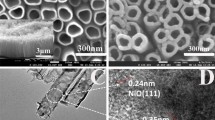Abstract
The different morphologies of K-doped ZnO nanostructures were successfully synthesized by a facile one-step electrochemical method using control of the current density. Field emission electron microscope images showed various morphologies and aspect ratios due to change in the value of applied current densities. Photoluminescence and UV-visible spectrometers showed that change in current densities leads in different level of defects and band gap shifting. The photocurrent responses reveal that the photocurrent intensity increases as K-doped ZnO surface morphology tends to taper on the application of 0.5 mA cm−2 current density. The maximum degradation rate of methylene blue was attained to be 99.3% within the 60 min using K-doped ZnO nanotapers which was much higher than the values found in previous studies. The highest photocatalytic H2 evolution activities were obtained in the applied current density of 0.5 mA cm−2 in comparison to other samples. These results indicate that doping and controllable morphology are effective and facile methods to improve the photocatalytic features of ZnO by boosting the absorption of light.









Similar content being viewed by others
References
Eveloy V, Karunkeyoon W, Rodgers P, Al Alili A (2016) Energy, exergy and economic analysis of an integrated solid oxide fuel cell–gas turbine–organic Rankine power generation system. Int J Hydrog Energy 41(31):13843–13858
Matsakas L, Gao Q, Jansson S, Rova U, Christakopoulos P (2017) Green conversion of municipal solid wastes into fuels and chemicals. Electron J Biotechnol 26:69–83
Kang Y, Yang Y, Yin LC, Kang X, Liu G, Cheng HM (2015) An amorphous carbon nitride photocatalyst with greatly extended visible-light-responsive range for photocatalytic hydrogen generation. Adv Mater 27(31):4572–4577
Pan L, Wang S, Xie J, Wang L, Zhang X, Zou J-J (2016) Constructing TiO2 pn homojunction for photoelectrochemical and photocatalytic hydrogen generation. Nano Energy 28:296–303
Rouhi J, Alimanesh M, Mahmud S, Dalvand R, Ooi CR, Rusop M (2014) A novel method for synthesis of well-aligned hexagonal cone-shaped ZnO nanostructures in field emission applications. Mater Lett 125:147–150
Ge M, Cao C, Huang J, Li S, Chen Z, Zhang K-Q, Al-Deyab S, Lai Y (2016) A review of one-dimensional TiO 2 nanostructured materials for environmental and energy applications. J Mater Chem A 4(18):6772–6801
Rouhi J, Alimanesh M, Dalvand R, Ooi CR, Mahmud S, Mahmood MR (2014) Optical properties of well-aligned ZnO nanostructure arrays synthesized by an electric field-assisted aqueous solution method. Ceram Int 40(7):11193–11198
Raza W, Faisal SM, Owais M, Bahnemann D, Muneer M (2016) Facile fabrication of highly efficient modified ZnO photocatalyst with enhanced photocatalytic, antibacterial and anticancer activity. RSC Adv 6(82):78335–78350
Rouhi J, Mamat MH, Ooi CR, Mahmud S, Mahmood MR (2015) High-performance dye-sensitized solar cells based on morphology-controllable synthesis of ZnO–ZnS heterostructure nanocone photoanodes. PLoS One 10(4):e0123433
Cao S, Yan X, Kang Z, Liang Q, Liao X, Zhang Y (2016) Band alignment engineering for improved performance and stability of ZnFe2O4 modified CdS/ZnO nanostructured photoanode for PEC water splitting. Nano Energy 24:25–31
Alshammari AS, Chi L, Chen X, Bagabas A, Kramer D, Alromaeh A, Jiang Z (2015) Visible-light photocatalysis on C-doped ZnO derived from polymer-assisted pyrolysis. RSC Adv 5(35):27690–27698
Khodadadi A, Faghih-Mirzaei E, Karimi-Maleh H, Abbaspourrad A, Agarwal S, Gupta VK (2019) A new epirubicin biosensor based on amplifying DNA interactions with polypyrrole and nitrogen-doped reduced graphene: experimental and docking theoretical investigations. Sensors Actuators B Chem 284:568–574
Alimanesh M, Rouhi J, Hassan Z (2016) Broadband anti-reflective properties of grown ZnO nanopyramidal structure on Si substrate via low-temperature electrochemical deposition. Ceram Int 42(4):5136–5140
Eswar K, Rouhi J, Husairi F, Dalvand R, Alrokayan SA, Khan HA, Mahmood MR, Abdullah S (2014) Hydrothermal growth of flower-like ZnO nanostructures on porous silicon substrate. J Mol Struct 1074:140–143
He L, Dou X, Li X, Qin L, Kang S-Z (2018) Remarkable enhancement of the photocatalytic activity of ZnO nanorod array by utilizing energy transfer between Eosin Y and Rose Bengal for visible light-driven hydrogen evolution. Int J Hydrog Energy 43(32):15255–15261
Juwhari HK, Ikhmayies SJ, Lahlouh B (2017) Room temperature photoluminescence of spray-deposited ZnO thin films on glass substrates. Int J Hydrog Energy 42(28):17741–17747
Husairi M, Rouhi J, Alvin K, Atikah Z, Rusop M, Abdullah S (2014) Developing high-sensitivity ethanol liquid sensors based on ZnO/porous Si nanostructure surfaces using an electrochemical impedance technique. Semicond Sci Technol 29(7):075015
Najaafi N (2019) Photovoltaic behavior of K-doped ZnO nanorods synthesized by a facile electrochemical route. J Mater Sci Mater Electron 30(10):9931–9937
Qi L, Shahzad MB, Qi Y (2016) A reproducible low temperature chemical solution deposition of non-polar [112 0] and [101 0] ZnO films for optoelectronic applications. CrystEngComm 18(35):6573–6578
Eom TH, Han JI (2018) Single fiber UV detector based on hydrothermally synthesized ZnO nanorods for wearable computing devices. Appl Surf Sci 428:233–241
Dev A, Kar S, Chakrabarti S, Chaudhuri S (2006) Optical and field emission properties of ZnO nanorod arrays synthesized on zinc foils by the solvothermal route. Nanotechnology 17(5):1533–1540
Husairi F, Rouhi J, Eswar K, Ooi CR, Rusop M, Abdullah S (2015) Ethanol solution sensor based on ZnO/PSi nanostructures synthesized by catalytic immersion method at different molar ratio concentrations: an electrochemical impedance analysis. Sensors Actuators A Phys 236:11–18
Chou SY, Ding W (2013) Ultrathin, high-efficiency, broad-band, omni-acceptance, organic solar cells enhanced by plasmonic cavity with subwavelength hole array. Opt Express 21(101):A60–A76
Karimi-Maleh H, Fakude CT, Mabuba N, Peleyeju GM, Arotiba OA (2019) The determination of 2-phenylphenol in the presence of 4-chlorophenol using nano-Fe3O4/ionic liquid paste electrode as an electrochemical sensor. J Colloid Interface Sci 554:603–610
Li Y, Wang S, He Y-B, Tang L, Kaneti YV, Lv W, Lin Z, Li B, Yang Q-H, Kang F (2017) Li-ion and Na-ion transportation and storage properties in various sized TiO 2 spheres with hierarchical pores and high tap density. J Mater Chem A 5(9):4359–4367
Author information
Authors and Affiliations
Corresponding author
Additional information
Publisher’s note
Springer Nature remains neutral with regard to jurisdictional claims in published maps and institutional affiliations.
Rights and permissions
About this article
Cite this article
Rouhi, J., Kakooei, S., Sadeghzadeh, S.M. et al. Highly efficient photocatalytic performance of dye-sensitized K-doped ZnO nanotapers synthesized by a facile one-step electrochemical method for quantitative hydrogen generation. J Solid State Electrochem 24, 1599–1606 (2020). https://doi.org/10.1007/s10008-020-04695-y
Received:
Revised:
Accepted:
Published:
Issue Date:
DOI: https://doi.org/10.1007/s10008-020-04695-y




